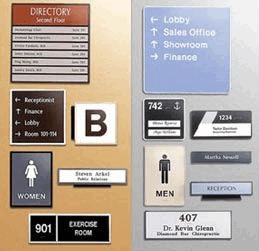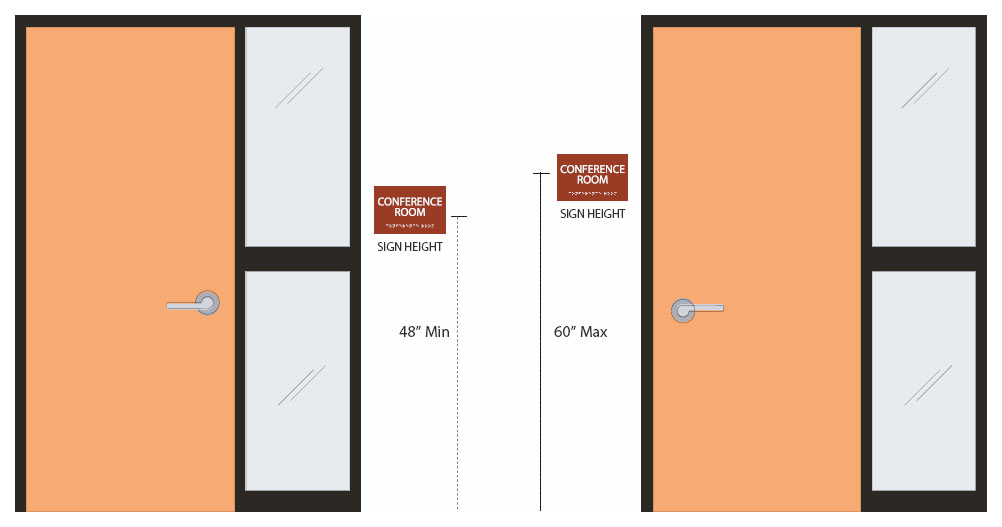A Comprehensive Guide to Picking the Right ADA Signs
A Comprehensive Guide to Picking the Right ADA Signs
Blog Article
ADA Signage: Making Certain Availability and Conformity in Public Spaces
ADA signage plays a crucial duty in guaranteeing accessibility and conformity within public rooms, dramatically adding to an inclusive environment for people with specials needs. As we explore the nuances of ADA signs, from responsive features to design complexities, it's vital to consider how these aspects coalesce to maintain the civil liberties of all users.
Significance of ADA Signs
In modern culture, the significance of ADA signs extends past mere compliance with legal requireds to personify a dedication to inclusivity and accessibility for all individuals. These indicators are crucial in producing atmospheres where individuals with specials needs can browse public rooms with the same simplicity and freedom as those without impairments. By supplying clear and standardized info, ADA signage makes certain that everyone can access centers, solutions, and info without obstacles.
The value of ADA signage lies in its ability to improve the top quality of life for individuals with impairments by promoting equivalent gain access to. It removes the obstacles that could or else hinder their ability to participate totally in area life. These signs offer as visible signs of an organization's devotion to diversity and equality, showing wider societal values that promote the civil liberties and dignity of all individuals.
Additionally, ADA signs plays an essential role in public safety. By directing individuals to departures, restrooms, and other vital facilities, it makes certain that all individuals, despite physical ability, can evacuate securely during emergency situations. In recap, ADA signage is not simply a regulatory demand however an effective tool for promoting a comprehensive and equitable culture.
Crucial Element of Compliance

Placement is vital; indicators need to be installed in places that are reachable and quickly noticeable. Typically, signs must be placed between 48 and 60 inches from the ground to make sure ease of access for both standing and mobility device users. Responsive elements, such as Braille, are crucial for individuals with aesthetic impairments, offering crucial details in a non-visual layout.
High-contrast colors in between the text and history are required to boost readability for individuals with reduced vision. The ADA mandates details contrast ratios to ensure quality. In addition, personality dimension is an essential factor to consider, with minimal height requirements determined by the checking out distance to make certain readability from various angles.
Layout Considerations for Accessibility
Designing obtainable signs calls for a careful method to ensure it fulfills the requirements of all customers, particularly those with impairments. The size of the text is equally vital, with ADA standards advising a minimum height based on viewing range to ensure readability.
Contrasting colors in between message and history are vital for visibility, specifically for people with aesthetic disabilities. A high reference contrast ratio assists distinguish the text from its history, boosting readability under various illumination conditions. Additionally, responsive aspects, such as Braille and elevated personalities, are important for people that are blind or have low vision. These components need to be situated at a consistent elevation and setting to guarantee simple access and comprehension.
Furthermore, the positioning of signage plays a considerable duty in accessibility. Indicators this page ought to be mounted in places that are unhampered and conveniently obtainable. Guaranteeing that signage is installed at proper heights and angles allows all users, consisting of those utilizing mobility devices, to engage with them effectively.
Usual Errors to Avoid

An additional widespread error is the incorrect placement of signage. ADA standards specify exact height and area needs to make certain that indications are obtainable and quickly noticeable by all people, consisting of those making use of wheelchairs. Neglecting these standards not only obstructs ease of access but likewise risks non-compliance with legal standards.
Furthermore, inadequate comparison between text and history is a constant oversight. Ample comparison is necessary for readability, specifically for individuals with reduced vision. Designers often pick shades that are visually enticing but do not have the required comparison, providing webpage the message challenging to recognize.
Finally, some developers fail to integrate responsive components, such as Braille, which are vital for people who are blind. Omitting these attributes not only results in non-compliance with ADA laws yet additionally restricts accessibility for a section of the populace that depends on responsive info.
Future Trends in Signage
Advancements in modern technology and boosting recognition of inclusivity are forming the future fads in signage style. Digital signage, for instance, is evolving to include real-time updates and interactive features, which can be essential in providing vibrant information in public spaces.
An additional emerging pattern is the application of augmented reality (AR) to enhance customer experience. AR-enabled signage can overlay electronic information onto the physical atmosphere, providing visually damaged individuals with auditory or haptic comments. ADA Signs. This innovation not just improves ease of access yet also develops an appealing experience for all users
Sustainability is additionally a substantial variable influencing signage trends. Environmentally friendly materials and energy-efficient lighting solutions are being prioritized to align with worldwide environmental objectives. Furthermore, improvements in materials scientific research are causing the growth of more weather-resistant and resilient indicators.
Verdict
ADA signage plays an important function in ensuring access and compliance within public spaces by incorporating responsive components, high-contrast colors, and strategic positioning. The adherence to ADA requirements not only facilitates secure navigating for individuals with specials needs however likewise symbolizes an organization's dedication to diversity and inclusivity. By avoiding typical errors and accepting future patterns, public spaces can continue to progress these worths, ensuring that the rights and dignity of all people are appreciated and maintained.
ADA signage plays an indispensable role in ensuring access and conformity within public rooms, substantially adding to an inclusive environment for individuals with handicaps. As we discover the subtleties of ADA signage, from tactile attributes to create ins and outs, it's important to take into consideration how these components coalesce to maintain the rights of all individuals.In modern-day culture, the relevance of ADA signage prolongs past plain conformity with lawful requireds to personify a dedication to inclusivity and access for all individuals. By supplying standard and clear details, ADA signs ensures that everybody can access centers, solutions, and info without obstacles.
ADA signage plays a vital role in guaranteeing ease of access and compliance within public areas by incorporating tactile components, high-contrast shades, and critical positioning. (ADA Signs)
Report this page